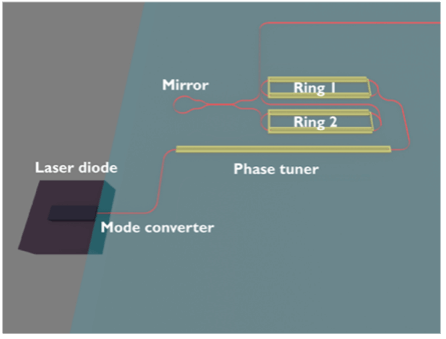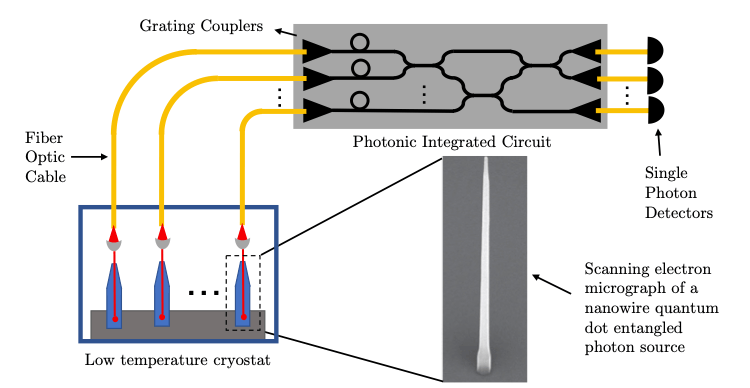Atoms can be controlled by manipulating their internal states using agile, quiet and reliable laser sources. An external-cavity diode laser (ECDL) is a crucial enabling technology to realize such laser sources since it allows for the narrowing of the linewidth of a laser diode and precise tuning of the laser frequency. This project aims to miniaturize the external cavity using a photonic integrated circuit (PIC) (i.e., a single chip), which will increase the reliability and functionality of the optical frequency source for quantum experiments. A PIC ECDL will be designed and fabricated using aluminum nitride (AlN). Since several atomic transitions of interest in quantum applications are in the visible spectrum, AlN is an ideal material due to its large bandgap that allows for low-loss waveguide propagation. AlN also enables key functionality for preparing narrow linewidth and agile optical frequencies. Thus, an AlN waveguide will be fabricated and tested to ensure low waveguide losses at visible wavelengths. An external cavity feedback laser will be fabricated by coupling a laser diode directly into the AlN waveguide. A micro-ring resonator feedback circuit will be used to select and narrow the laser output. The light will be further coupled into fibre optics for delivery to atoms in a vacuum chamber, demonstrating the viability of using PIC ECDLs to interact with atomic energy levels. This AlN PIC ECDL would be a compact optical frequency source that could help enhance existing quantum experiments, enable experiments currently unviable with bulk optical setups and allow for the translation of quantum atomic technologies out of the laboratory (i.e., large-scale quantum computation, high-precision gravimeters for resource mapping and portable optical atomic clocks).

Figure 1. A conceptual render of an external cavity diode laser in an aluminum nitride integrated photonic circuit.
Related Content

Next Generation Quantum Sensors
We are developing new semiconductor p-n junctions and designing novel nanowire arrays that have the potential to significantly enhance the ability to detect light at the single photon level over an unprecedented wavelength range from the ultraviolet to infrared.
June 1, 2017

Enabling Next-Generation Sustainable Computing through Novel Multi-Valued-Logic Quantum Devices
As the demand for digital services grows, so does the need for data centres and transmission networks. Unfortunately, these data systems consume vast amounts of energy, resulting in nearly 1% of all energy-related greenhouse gas emissions. This project aims to invent novel quantum devices for highly energy-efficient computing that may help reduce the global digital […]
June 12, 2023

Photonic Quantum Processor
Photonic quantum processors based on integrated quantum photonic circuits require entangled photon pairs to perform quantum computations. However, current state-of-the-art technologies utilize probabilistic entangled photon sources with limited pair-extraction efficiencies, negatively affecting the computation speed. This project aims to boost the speed of on-chip quantum operations by using bright, on-demand entangled photon sources with an […]
April 24, 2023

Inverse Photoemission Spectroscopy of Quantum Materials
Summary Quantum materials that exhibit strong electron correlations lead to phenomena, such as superconductivity and topologically protected states, that are important for quantum computation, sensing, and other applications. For example, we may utilize symmetry protected topological states to make qubits that are robust against decoherence, while advances in high temperature superconductors may significantly reduce […]
September 20, 2018

